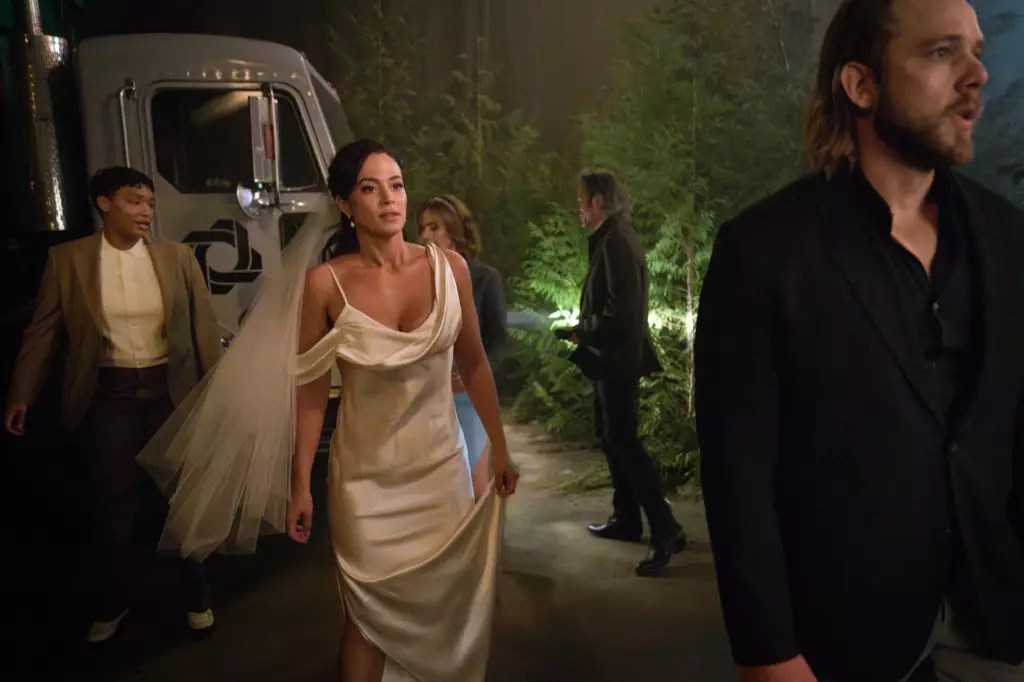As the adrenaline-fueled drama “Fire Country” returned for its much-anticipated third season, viewers were immediately thrust into a whirlwind of chaos during the season premiere titled “What the Bride Said.” The episode delivered unexpected twists as a helicopter crash devastated a wedding ceremony—unlike conventional romantic storylines, this incident provided a captivating blend of action and emotional stakes. This unique approach keeps audiences engaged while navigating the intricate landscape of the show’s character dynamics and plot developments.
The wedding between Diego and Gabriela stands at the heart of the premiere episode, and it serves as a manifestation of the show’s ethos: a blend of heroic action with human emotion. While one might expect traditional wedding day jitters and runaway brides, the writers opted for an explosive narrative device that puts characters to the test. Showrunner Tia Napolitano decided that instead of allowing the will-they-or-won’t-they drama between Bode and Gabriela to dominate, the story would erupt into crisis almost immediately. The result is a scene that challenges the expectations of the genre by merging a heartfelt ceremony with a terrifying calamity.
The decision to crash a helicopter into the wedding exemplifies the show’s commitment to unpredictability. Napolitano explains that the writers wanted their wedding to stand apart from cliched scenarios that viewers are used to. By utilizing high-stakes action, the narrative sustains a gripping, relentless pace that demands the attention of fans. This move illustrates a bold creative choice that prioritizes spectacle without sacrificing the emotional resonance of the characters’ struggles.
In light of the helicopter crash, the characters’ responses provide insight into their multifaceted personalities. The scene demonstrates Gabriela’s fierce determination, as she shifts from bride to active participant in rescuing the injured—an act that might evoke skepticism but ultimately resonates as a testament to her character’s strength. Napolitano addresses the ‘suspending disbelief’ factor, emphasizing that the spirit of the show resides in its characters stepping outside their comfort zones in extreme conditions.
While some viewers may question the believability of Gabriela saving lives in a wedding dress, her action symbolizes the show’s recurrent theme—ordinary people becoming heroes in extraordinary circumstances. Instead of being bound to their roles, the characters embrace unpredictability and make choices that reflect their core attributes, urging viewers to engage more deeply with their journeys.
Central to the narrative is the complex relationship between Manny and his daughter Gabriela, particularly regarding her feelings for Bode. Napolitano articulates that Manny’s apprehensions arise not solely from a protective fatherly instinct but from personal experiences that taint his perception of love. Bode and Gabriela’s connection echoes his past relationship with Roberta, which he found unhealthy—an acknowledgment that sets the thematic stage for exploring familial legacies and the burden they carry.
This nuance reinforces the notion that the intensity of relationships is often informed by one’s history. The show dives into layered storytelling that resonates with audiences, illustrating that love is not as straightforward as it appears. It also holds space for the characters to confront their own fears, shaping their paths as they grapple with whether to follow their hearts or heed their reservations.
As the latest season unfolds, the thematic exploration of legacy becomes increasingly prominent. Bode’s journey is framed by his eagerness to claim his place within the Leone firefighting lineage, marking a shift from a man adrift to one who is willing to embrace his roots. Napolitano hints at an intertwining narrative that delves into not just Bode’s ascent but the histories of new characters, like Eve, and the multi-generational narratives that shape their arcs.
This layered storytelling invites viewers to consider the complexities of identity, the scars of the past, and the legacies we inherit or seek to redefine. The introduction of characters such as Captain Casey—played by Jared Padalecki—adds further richness, hinting at future collaborations and fusion of storylines that may provide avenues for spin-offs and interconnected storytelling within the show’s universe.
As “Fire Country” gains traction with its character-driven narrative, explosive action, and emotional depth, it impressively lays the groundwork for the season ahead. This combination ensures a dedicated viewer base eager to witness how the consequences of the helicopter crash unfold and how relationships evolve amidst chaos. As the characters confront their pasts and navigate their present, audiences are left to wonder just how far they will go to reclaim their legacies and forge their paths. With multiple story arcs eager to be explored and new characters on the horizon, the world of “Fire Country” promises to be an exhilarating ride that leaves viewers breathless yet invested.


Leave a Reply